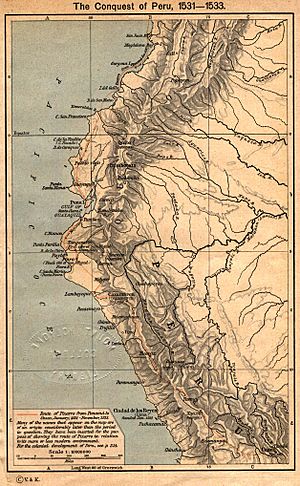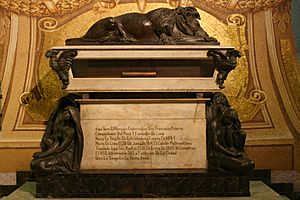Francisco Pizarro facts for kids
Quick facts for kids
The Most Excellent
The Marquess of the Atabillos
|
|
|---|---|
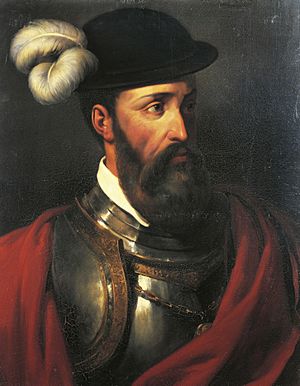
Portrait of Francisco Pizarro by Amable-Paul Coutan, 1835
|
|
| 1st Governor of New Castile | |
| In office 26 July 1529 – 26 June 1541 |
|
| Monarch | Charles I |
| Succeeded by | Cristóbal Vaca de Castro |
| Captain General of New Castile | |
| In office 26 July 1529 – 26 June 1541 |
|
| Personal details | |
| Born | c. 16 March 1478 Trujillo, Crown of Castile |
| Died | 26 June 1541 (aged c. 63) Lima, New Castile |
| Spouse | Inés Huaylas Yupanqui |
| Children | Francisca Pizarro Yupanqui |
| Signature |  |
| Nickname | Apu ("chief" in Quechua) or Machu Capitan ("Old Captain" in Quechua) |
| Military service | |
| Allegiance | |
| Years of service | 1496–1541 |
| Battles/wars | Spanish conquest of Peru
|
Francisco Pizarro (born around 1478 – died 1541) was a Spanish explorer and soldier. He is famous for leading the Spanish conquest of the Inca Empire in South America.
Pizarro was born in Trujillo, Spain, into a poor family. He decided to seek adventure and wealth in the 'New World' (the Americas). He traveled to Panama and was one of the first Europeans to see the Pacific Ocean from the Americas. After some unsuccessful trips, he got permission from the Spanish king to conquer Peru. His third journey was a success.
When local people fought back, Pizarro moved inland. He founded the first Spanish town in Peru, called San Miguel de Piura. In 1532, Pizarro captured the Inca emperor, Atahualpa, during the Battle of Cajamarca. Atahualpa offered a huge amount of gold and silver for his freedom. But Pizarro charged him with crimes and had him executed in 1533. The same year, Pizarro entered the Inca capital of Cuzco. This completed his conquest of Peru. In 1535, he founded the city of Lima. Pizarro was later killed in 1541 due to power struggles.
Contents
Early Life of Francisco Pizarro
Francisco Pizarro was born in Trujillo, Spain. This area was then part of the Crown of Castile. He was the son of Gonzalo Pizarro, an army colonel, and Francisca González. His mother was a poor woman. His exact birth date is not known, but it was likely around 1475. He did not receive much schooling and grew up unable to read or write.
His father fought in wars in Navarre and Italy. Francisco also had a half-brother, Francisco Martín de Alcántara, who joined him in Peru. Through his father, Francisco was a distant cousin of the famous explorer Hernán Cortés.
Pizarro's Early Career as a Conquistador
In 1509, Pizarro sailed from Spain to the New World with Alonso de Ojeda. They went on an expedition to Urabá. Pizarro took part in Ojeda's failed colony. He led the remaining people until they left the area. He then sailed to Cartagena and joined Martín Fernández de Enciso's fleet.
In 1513, Pizarro went with Vasco Núñez de Balboa. They crossed the Isthmus of Panama to reach the Pacific Ocean. The next year, Pedro Arias Dávila became the new governor of Castilla de Oro. Pizarro became a close friend of Dávila. The governor gave him land and native people to work it. Dávila later ordered Pizarro to arrest Balboa. Balboa was executed in 1519. For his loyalty, Pizarro became mayor and judge of Panama City from 1519 to 1523.
Expeditions to South America
In 1522, Pascual de Andagoya tried to explore western South America. The native people he met told him about a rich land called Virú. It was on a river called Pirú, which later became Perú. Andagoya met several native chiefs. He heard stories about "Pirú" being a land full of gold. These stories, and the success of Cortés in Mexico, interested Pizarro. This led him to plan his own expeditions to the south.
In 1524, Pizarro formed a team in Panama. He partnered with a priest named Hernando de Luque and a soldier named Diego de Almagro. They agreed to explore and conquer the South. They decided Pizarro would lead the trip. Almagro would get soldiers and food. Luque would handle money and supplies.
First Expedition (1524)
In November 1524, the first expedition left Panama to conquer Peru. It had about 80 men and 4 horses. Diego de Almagro stayed behind to find more men and supplies. The governor of Panama, Pedro Arias Dávila, first approved the trip.
Pizarro's first expedition was not successful. His men sailed down the Pacific coast. They did not get past Colombia. They faced bad weather, little food, and fights with native people. Almagro even lost an eye from an arrow. The places they named, like Puerto del Hambre (port of hunger), showed their difficulties. Pizarro ended this first trip and went back to Panama.
Second Expedition (1526)
Two years later, Pizarro, Almagro, and Luque planned a second expedition. Panama's governor, Pedrarias Dávila, was not sure about it. He had lost trust in Pizarro. But the three partners convinced him. A new governor, Pedro de los Ríos, took over in 1526. He also approved Pizarro's trips at first.
On March 10, 1526, Pizarro left Panama with two ships. He had 160 men and several horses. They reached the San Juan River in Colombia. Pizarro stayed to explore the difficult coast. Almagro went back to Panama for more men. Pizarro's main pilot, Bartolomé Ruiz, sailed south. He crossed the equator and found a raft with native people from Tumbes. These people had textiles, pottery, and some gold, silver, and emeralds. Ruiz's findings became very important for this expedition. Some natives came aboard Ruiz's ship to help as interpreters.
Ruiz then sailed north to find Pizarro. Pizarro and his men were tired from exploring. Soon, Almagro arrived with supplies and 80 new recruits from Spain. Ruiz's good news and Almagro's new men cheered everyone up. They decided to sail back to the area Ruiz had explored. After a hard journey, they reached Atacames on the Ecuadorian coast. Here, they found many native people who were under Inca rule. The Spanish decided not to go ashore because the people seemed strong and numerous.
The Famous Thirteen
Pizarro and Almagro argued a lot. They decided Pizarro would stay at Isla de Gallo, a safer place near the coast. Almagro would go back to Panama with Luque for more help. They would bring proof of the gold and news of the rich land. The new governor of Panama, Pedro de los Ríos, had heard about Pizarro's problems. He refused to give more resources. He also sent two ships to bring Pizarro and his crew back to Panama.
Pizarro did not want to return. When the ships arrived, Pizarro drew a line in the sand. He said, "There lies Peru with its riches; Here, Panama and its poverty. Choose, each man, what best becomes a brave Castilian. For my part, I go to the south."
Only 13 men stayed with Pizarro. They became known as "The Famous Thirteen." The rest of the men went back to Panama. Ruiz left in one of the ships to join Almagro and Luque. Soon after the ships left, Pizarro and his men built a simple boat. They traveled north to La Isla Gorgona. They stayed there for seven months, waiting for new supplies.
Back in Panama, Luque finally convinced Governor Pedro de los Ríos. He allowed one more ship, but only to bring Pizarro back within six months. Almagro and Luque took this chance. They left Panama (without new recruits) for La Isla Gorgona to meet Pizarro. They decided to keep sailing south. This was based on what Ruiz's native interpreters had said.
By April 1528, they reached the Tumbes Region in northwestern Peru. Tumbes was the first success the Spanish had wanted for so long. The local people, the Tumpis, welcomed them warmly. Two of Pizarro's men, Alonso de Molina and Pedro de Candia, explored the area. Both reported back about the land's riches. They saw silver and gold decorations in the chief's home. They also saw the Peruvian llama for the first time. Pizarro called them "little camels." The expedition heard about a powerful ruler over the land they were exploring. These events convinced them that Peru was very wealthy. The explorers decided to return to Panama. They would prepare for a final conquest with more men and supplies. Before leaving, Pizarro and his men sailed south along the coast. They wanted to see if anything else interesting could be found.
On their way back to Panama, Pizarro stopped briefly at Tumbes. Two of his men stayed there to learn the customs and language of the natives. Pizarro also took two Peruvian boys to learn Spanish. One was later named Felipillo and became an important interpreter. The other was called Martinillo. Their last stop was La Isla Gorgona, where two of his sick men had stayed. After at least 18 months away, Pizarro and his followers arrived back in Panama. They prepared for their final expedition.
Capitulación de Toledo
The new governor of Panama, Pedro de los Ríos, refused a third expedition. So, Pizarro decided to go to Spain and ask the king directly. Pizarro sailed from Panama to Spain in 1528. He brought Pedro de Candia, some native people, llamas, and samples of fabric, gold, and silver.
Pizarro reached Seville in early summer. King Charles I was in Toledo. He met Pizarro and heard about his trips in South America. Pizarro described the land as rich in gold and silver. He said he and his men had bravely explored it "to extend the empire of Castile." The king was impressed and promised his support. Queen Isabel signed the Capitulación de Toledo on July 6, 1529. This document allowed Pizarro to conquer Peru. Pizarro was officially named the Governor and Captain General of New Castile. He was given much power. His partners were given less important roles. This later made Almagro angry and caused problems. One condition was that Pizarro had to gather 250 men within six months.
This gave Pizarro time to go to his hometown of Trujillo. He convinced his brother Hernando Pizarro and other friends to join him. Francisco de Orellana also joined. He would later discover the Amazon River. Two of his half-brothers, Juan Pizarro and Gonzalo Pizarro, and another half-brother, Francisco Martín de Alcántara, also joined. His cousin Pedro Pizarro became his page. When the expedition left the next year, it had three ships, 180 men, and 27 horses.
Pizarro could not gather all the men required. He secretly sailed from Sanlúcar de Barrameda in January 1530. His brother Hernando and the remaining men joined him in La Gomera. Pizarro's third and final expedition left Panama for Peru on December 27, 1530.
Conquest of Peru (1532)
In 1531, Pizarro landed near Ecuador. He found some gold, silver, and emeralds. He sent these to Almagro, who was still in Panama getting more men. Sebastián de Belalcázar soon arrived with 30 men. Pizarro wanted to go to Tumbes, but he had to fight the Punian natives in the Battle of Puná. Three or four Spanish soldiers died. Soon after, Hernando de Soto joined with 100 volunteers and horses. They sailed to Tumbes, but found it empty and destroyed. The local chiefs explained that fierce tribes had attacked them.
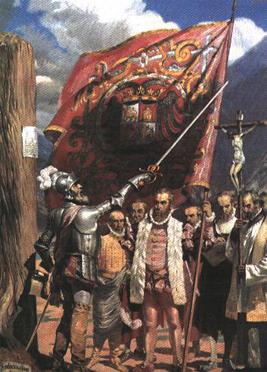
Since Tumbes was not safe, Pizarro went inland in May 1532. He founded the first Spanish settlement in Peru, San Miguel de Piura. He left 50 men there. Pizarro continued his conquest with 200 men on September 24, 1532. After reaching Zaran, de Soto went to a Peruvian army camp. He returned with a message from the Inca emperor, Atahualpa. Atahualpa invited Pizarro to visit his camp.
Atahualpa had just defeated his brother, Huáscar, in a civil war. He was resting near Cajamarca. Pizarro arrived at Cajamarca on November 15, 1532. He had only 110 foot soldiers, 67 cavalry, three arquebuses (early guns), and two small cannons. Pizarro sent Hernando Pizarro and de Soto to meet Atahualpa. Atahualpa agreed to meet Pizarro in the Cajamarca plaza the next day. A priest, Fray Vicente de Valverde, and an interpreter, Felipillo, met Atahualpa. The priest told Atahualpa about Christianity and that he should pay tribute to King Charles V. Atahualpa replied, "I will be no man's tributary." He felt safe because he had 50,000 soldiers, and 6,000 were with him. Pizarro had fewer than 200 men. This decision sealed his fate and that of the Inca empire.
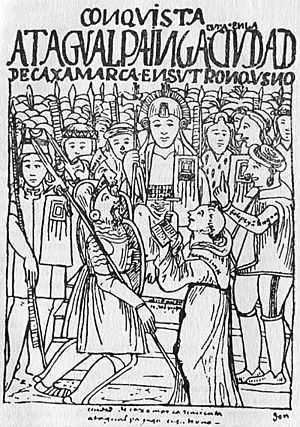
Atahualpa's refusal led Pizarro to attack the Inca army. This was the Battle of Cajamarca on November 16, 1532. The Spanish won. Pizarro captured Atahualpa. By February 1533, Almagro joined Pizarro with 150 more men and 50 horses.
Atahualpa promised to fill one room with gold and two with silver for his freedom. He kept his promise. But Pizarro accused him of 12 crimes, including killing his brother. Atahualpa was executed on August 29, 1533. Francisco Pizarro and de Soto did not want Atahualpa killed. But Francisco agreed to the trial because of "great agitation among the soldiers," especially from Almagro. De Soto was away during the trial and execution. When he returned, he was upset. He said Atahualpa "should have been taken to Castile and judged by the emperor." King Charles later wrote to Pizarro that he was "displeased by the death of Atahualpa."
Pizarro marched with his army of 500 Spaniards toward Cuzco. Chalcuchimac, an Inca general who supported Atahualpa, was with them. He was later burned at the stake. Manco Inca Yupanqui joined Pizarro after another Inca leader died. When Pizarro explored Cuzco, he was very impressed. He wrote to King Charles I, saying: "This city is the greatest and the finest ever seen in this country... It is so beautiful and has such fine buildings that it would be remarkable even in Spain."
The Spanish completed their conquest of Peru by entering Cuzco on November 15, 1533. Jauja was made Peru's temporary capital in April 1534. But it was too high in the mountains and far from the sea. Pizarro founded the city of Lima on Peru's central coast on January 6, 1535. He considered this one of his most important achievements.
By early 1536, Manco Inca, with an army of about 100,000 people, began to attack Cuzco. Other Inca forces also attacked European strongholds. After three years of fighting, Inca leaders had learned Spanish military tactics. They developed ways to fight back. One effective method dealt with the Spanish advantage: horses. Inca soldiers would fight, then retreat into canyons. There, they would trap the Spanish cavalry with rocks and other weapons. This caused many Spanish deaths. Despite winning most battles, the Inca could not take Cuzco. The city's defenses were strong, and only 200 Spanish soldiers had gunpowder weapons. This showed the final victory of the Spanish.
After the Inca's last attempt to retake Cuzco failed, Pizarro and Almagro argued. They disagreed about who controlled Cuzco. The King of Spain had given Almagro the Governorate of New Toledo and Pizarro the Governorate of New Castile. Their disagreement was about where the border between these areas was. This led to fights between Pizarro's brothers and Almagro. Almagro was defeated in the Battle of Las Salinas in 1538 and executed. Almagro's son, also named Diego, was later stripped of his lands by Pizarro.
Atahualpa's wife, Cuxirimay Ocllo Yupanqui, was with Atahualpa's army. She stayed with him when he was imprisoned. After he was executed, she was taken to Cuzco. She was given the name Doña Angelina and became Francisco Pizarro's partner. By 1538, she had two sons with Pizarro, Juan and Francisco.
Pizarro's Death
In Lima, on June 26, 1541, a group of 20 armed men attacked Pizarro's palace. These men supported Diego de Almagro II, Almagro's son. They killed Pizarro. Then they forced the city council to name young Almagro as the new governor of Peru. When Pizarro fell, he reportedly drew a cross on the floor with his blood and kissed it before he died. A modern study of his remains showed he was attacked with many stab wounds to his head and neck. He also had wounds on his hands and arms from trying to defend himself.
Pizarro's body was first buried in the cathedral courtyard. Later, his head and body were separated and buried in different boxes under the cathedral floor. In 1892, a body believed to be Pizarro's was dug up and displayed in a glass coffin. However, in 1977, workers found a lead box in a sealed space. It had an inscription: "Here is the head of Marquess Don Francisco Pizarro who discovered and conquered the kingdoms of Peru." Scientists from the United States studied both bodies. They found that the body in the glass case was not Pizarro's. The skull in the lead box had marks from many sword blows. Its features also looked like portraits of Pizarro.
Pizarro's Legacy
Pizarro had a son, also named Francisco, with Quispe Sisa. This son married his relative Inés Pizarro, but they had no children. After Pizarro's death, Inés Yupanqui, an Inca princess and Atahualpa's sister, married a Spanish soldier named Ampuero. She went to Spain with her daughter. This daughter was later made legitimate by royal order. Francisca Pizarro Yupanqui later married her uncle, Hernando Pizarro, in Spain in 1537. Pizarro's third son, Francisco, by Dona Angelina, died soon after reaching Spain.
After his invasion, Pizarro ended the Inca state. He ruled the area for almost ten years. This led to the decline of local cultures. The Inca's religion, which had many gods, was replaced by Christianity. Many local people were forced to work for the Spanish elite. The cities of the Inca Empire were changed into Spanish Catholic cities. Pizarro is also criticized for ordering Atahualpa's death, even after the ransom was paid. Some Peruvians, especially those of native descent, view him negatively. However, until recently, Pizarro was often shown in a positive light, for example, in textbooks, for bringing Catholicism and creating a privileged class of mostly Spanish descent.
Sculptures of Pizarro
In the early 1930s, sculptor Ramsay MacDonald made three copies of a statue. It showed a European soldier with a helmet, sword, and riding a horse. The first copy was offered to Mexico to represent Cortés, but they did not accept it. This statue was taken to Lima in 1934 and used to represent Pizarro. Another copy of the statue is in Wisconsin. The statue of Pizarro on horseback in the Plaza Mayor in Trujillo, Spain, was made by American sculptor Charles Rumsey. His widow gave it to the city in 1926.
The statue in Lima stood near Peru's Government Palace for a long time. In 2003, after many requests, the mayor of Lima approved moving the statue. Since 2004, Pizarro's statue has been in a park. It is surrounded by restored 17th-century walls in the Rímac District. The statue faces the Rímac River and the Government Palace.
Palace of the Conquest

After returning from Peru with great wealth, the Pizarro family built a grand palace. It is on the corner of the Plaza Mayor in Trujillo, Spain. Francisca Pizarro Yupanqui and her uncle/husband Hernando Pizarro ordered the building of the palace. It has sculptures of them and others. It quickly became a famous symbol of the plaza.
The rich palace has four sections. It features the coat of arms of the Pizarro family on one of its corner balconies. The building has fancy decorations and railings.
Images for kids
See also
 In Spanish: Francisco Pizarro para niños
In Spanish: Francisco Pizarro para niños


